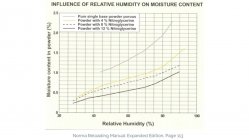Does anyone know of at what point the wet bulb or dewpoint are too high that would negatively effect reloading?
I used the terms wet bulb or dew point, because I keep seeing posts using relative humidity.
The true indicators of how much moisture is actually in the air are related to wet bulb, dewpoint, grains of moisture/lb of dry air, etc.
Unfortunately, relative humidity (RH) is basically a useless term, since it changes in relation to the dry bulb temperature.
With same amount moisture present, as the air temperature (dry bulb) decreases the relative humidity increases and vice versa.
With air at a wet bulb of 55 degrees and an air temperature (dry bulb) of 100, the relative humidity is about 22%, but the same air with an air temperature (dry bulb) of 55, the relative humidity is 100%.
You can't compare 50% RH in Colorado with dry bulb temps in mid teens to the Gulf Coast with dry bulb temps in the upper 90's.
I'm just trying to determine at what point there is too much moisture present to reload.
I used the terms wet bulb or dew point, because I keep seeing posts using relative humidity.
The true indicators of how much moisture is actually in the air are related to wet bulb, dewpoint, grains of moisture/lb of dry air, etc.
Unfortunately, relative humidity (RH) is basically a useless term, since it changes in relation to the dry bulb temperature.
With same amount moisture present, as the air temperature (dry bulb) decreases the relative humidity increases and vice versa.
With air at a wet bulb of 55 degrees and an air temperature (dry bulb) of 100, the relative humidity is about 22%, but the same air with an air temperature (dry bulb) of 55, the relative humidity is 100%.
You can't compare 50% RH in Colorado with dry bulb temps in mid teens to the Gulf Coast with dry bulb temps in the upper 90's.
I'm just trying to determine at what point there is too much moisture present to reload.












